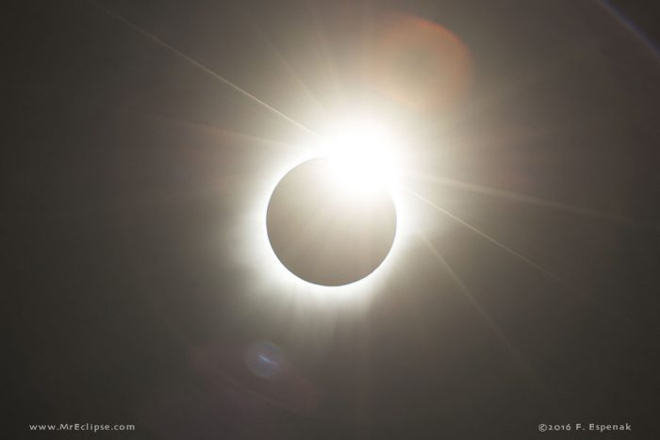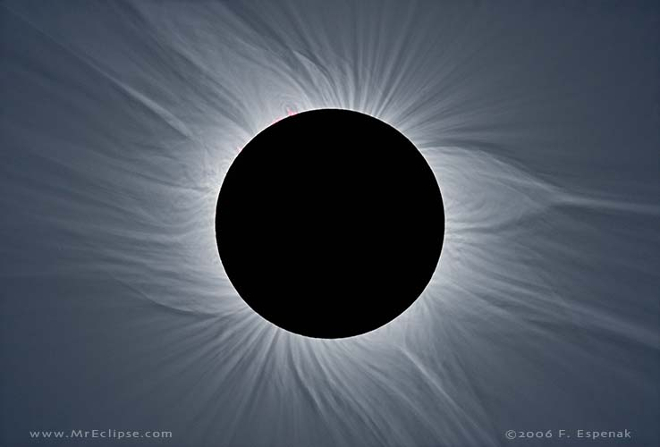 |
| A series of nine images were combined into a time sequence of the total solar eclipse of 1999 August 11, from Lake Hazar, Turkey. The corona has been computer enhanced to show subtle details and prominences. Copyright 1999 by Fred Espenak. |
EarthSky.org
So the big day – August 21 – is nearly here. Are you all ready for the 2017 total eclipse of the sun? It’s important to be prepared to take in everything the eclipse has to offer.
You’ll be outside for hours and there are a number of things you can do to make yourself comfortable.
Eclipse Day Checklist
Basic Checklist
– Solar filters for your eyes (partial phases only; filters are removed during totality; and bring extra filters to share). For reputable dealers endorsed by the American Astronomy Society, click here.
– Straw hat, kitchen pasta colander, or cooking spoon with small holes to project pinhole images of partially eclipsed sun on a white piece of cardboard (see: Safe Solar Eclipse Viewing)
– Suitable clothing and large brimmed hat (you will be outside in the sun for several hours)
– Sunglasses (not for direct viewing of partial phases)
– Comfortable folding chairs or picnic blanket to sit on
– Sunscreen lotion
– Bug repellent
– Basic first aid kit
– Cooler filled with water and drinks
– Snacks, sandwiches, etc.
– Roll of toilet paper (for emergencies)
– A list of your intended activities during the eclipse
– Times of the eclipse contacts for your location, which can be found using the EclipseWise 2017 Google Eclipse Map
– Digital watch or cell phone with accurate time, set on the day of eclipse
– A printed copy of this article to help you keep track of everything to watch during the eclipse.
Equipment Checklist for Viewing and/or Photographing Eclipse
– Binoculars and/or small telescope
– Solar filters for binoculars and/or telescope. For reputable dealers endorsed by the American Astronomy Society, click here
– Camera equipment and tripod
– Video camera and tripod
– Audio recorder for your comments and impressions or to capture reactions of people or wildlife near you
– Audio recorder with prerecorded messages timed to cue you about what to see next. There are some smart phone apps that do this , such as the Solar Eclipse Timer or EclipseDroid
– Extra batteries for all of the above
– Pencil and paper to record impressions or to sketch (also to take down the names and addresses of fellow observers!)
The August 21 total eclipse will last several hours. There will be many interesting things to look for. Here is a handy checklist of must-see events and effects, from eclipse gurus Fred Espenak and Mark Littmann.
First Contact – The moon begins to cover the western limb of the Sun. Remember to use safe solar filters to watch the partial phases of the eclipse.
Crescent Sun – Over a period of about an hour, the moon obscures more and more of the sun, as if eating away at a cookie. The Sun appears as a narrower and narrower crescent.
Light and Color Changes – About 15 minutes before totality, when 80% of the sun is covered, the light level begins to fall noticeably — and with increasing rapidity. The landscape takes on a metallic gray-blue hue.
Animal, Plant, and Human Behavior – As the level of sunlight falls, animals may become anxious or behave as if nightfall has come. Some plants close up. Notice how the people around you are affected.
Gathering Darkness on the Western Horizon – About 5 minutes before totality, the shadow cast by the Moon causes the western horizon to darken as if a giant but silent thunderstorm was approaching.
Temperature – As the sunlight fades, the temperature may drop perceptibly.
Shadow Bands – A minute or two before totality, ripples of light may flow across the ground and walls as Earth’s turbulent atmosphere refracts the last rays of sunlight.
Thin Crescent Sun – Only a sliver of the S\sun remains, then thinner still until . . .
Corona – Perhaps 15 seconds before totality begins, as the sun becomes the thinnest of crescents, the corona begins to emerge.
 |
| As totality ends, the sun begins to emerge from behind the moon, producing the dazzling diamond ring effect. Copyright 2016 by Fred Espenak. |
Diamond Ring Effect – As the corona emerges, the crescent sun has shrunk to a short, hairline sliver. Together they form a dazzlingly bright diamond ring. Then the brilliant diamond fades into . . .
Baily’s Beads – About 3 seconds before totality begins, the remaining crescent of sunlight breaks into a string of beads along the eastern edge of the moon. These are the last few rays of sunlight passing through deep valleys at the moon’s limb, creating the momentary effect of jewels on a necklace. Quickly, one by one, Baily’s Beads vanish behind the advancing moon as totality begins.
Shadow Approaching – While all this is happening, the moon’s dark shadow in the west has been growing. Now it rushes forward and envelops you.
Second Contact Totality Begins – The sun’s disk (photosphere) is completely covered by the moon. You can now remove your solar filters and safely look directly at the eclipse.
Prominences and the Chromosphere – For a few seconds after totality begins, the moon has not yet covered the lower atmosphere of the sun and a thin strip of the vibrant red chromosphere is visible at the sun’s eastern limb. Stretching above the chromosphere and into the corona are the vivid red prominences. A similar effect occurs along the sun’s western limb seconds before totality ends.
 |
| This image of the solar corona is a High Dynamic Range composite made from 22 separate exposures. The original images were shot by Espenak in Jalu, Libya during the total solar eclipse of March 29, 2016. The USPS used this image to create the Total Eclipse of the Sun, Forever® stamp. |
Planets and Stars Visible – Venus and Mercury are often visible near the eclipsed sun, and other bright planets and stars may also be visible, depending on their positions and the sun’s altitude above the horizon.
Landscape Darkness and Horizon Color – Each eclipse creates its own level of darkness, depending mostly on the moon’s angular size. At the far horizon all around you, beyond the moon’s shadow, the sun is shining and the sky has twilight orange and yellow colors.
Temperature – Is it cooler still? A temperature drop of about 10°F (6°C) is typical. The temperature continues to drop until a few minutes after third contact.
Animal, Plant, and Human Reactions – What animal noises can you hear? How are other people reacting? How do you feel?
End of Totality Approaching – The western edge of the moon begins to brighten and vividly red prominences and the chromosphere appear. Totality will end in seconds.
Third Contact – One bright point of the sun’s photosphere appears along the western edge of the moon. Totality is over. The stages of the eclipse repeat themselves in the reverse order.
Baily’s Beads – The point of light becomes two, then several beads, which fuse into a thin crescent with a dazzling bright spot emerging, a farewell diamond ring.
Diamond Ring Effect and Corona – As the diamond ring brightens, the corona fades from view. Daylight returns.
Shadow Rushes Eastward
Shadow Bands Reappear – Shadow Bands may be seen during the first 1-2 minutes after totality ends.
Crescent Sun – Partial phases occur in reverse order. Once again, you must use your solar filter to watch all the partial phases of the eclipse.
Recovery of Nature Partial Phase – Flowers open up, animals return to normal behavior, daylight regains its strength.
Fourth Contact – The moon no longer covers any part of the sun. The eclipse is over.